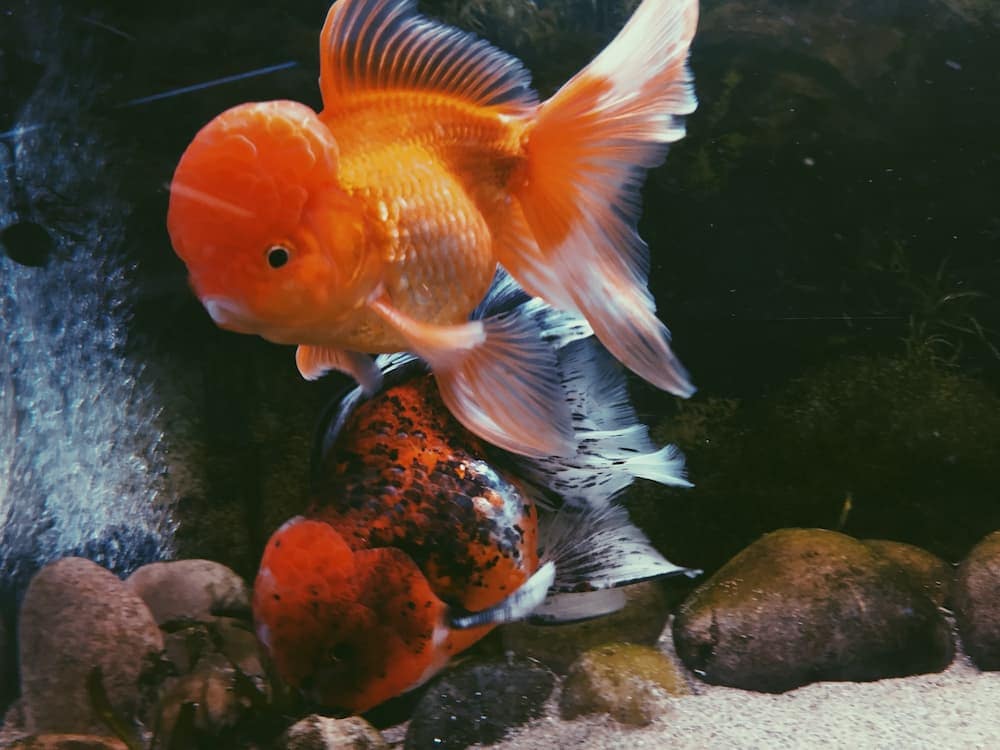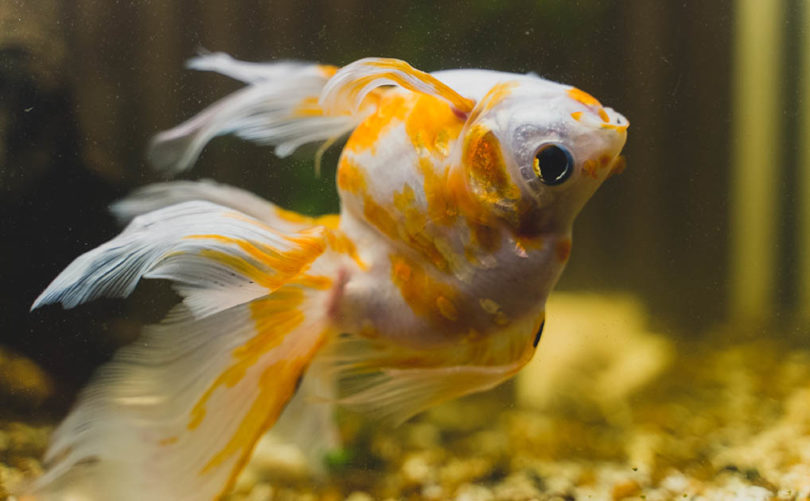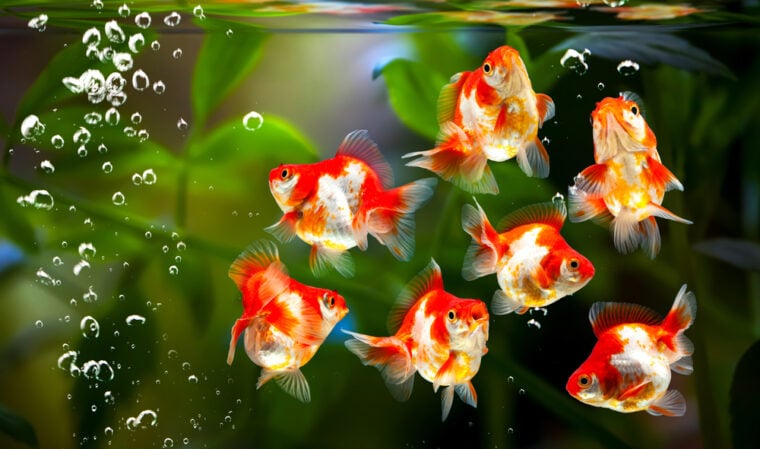
Breeding goldfish may seem like an exciting way to make goldfish keeping even more enjoyable. The journey to breeding goldfish is tricky, however, and you should ensure that you have the time and money to spend to produce healthy goldfish offspring.
Goldfish are prolific breeders, and therefore, the decision to breed your pet fish shouldn’t be taken lightly.
Successful goldfish breeding will involve several factors, including the parents’ lineage and history of illness. It is best to choose healthy goldfish with good morphology and no history of previous health issues like swim bladder disorder, tumors, or a poor body condition score.
This is a complete guide full of tips and tricks to help you breed the healthiest and most beautiful goldfish offspring.
The Ethics of Goldfish Breeding
Please note that the information in this article is for informational purposes only. At Pet Keen, we do not encourage breeding your goldfish. A single female goldfish can lay up to 1,000 eggs in one spawning session and over 10,000 eggs per breeding season. Females are also prone to being injured during the mating season, and the process places a very high demand on your fish.
You need vast numbers of tanks,a lot of money and time, and ample preparation before goldfish can spawn. It is also important to note that the process comes with its fair share of heartbreak as most fry (baby goldfish) are eventually culled. It is naive to assume that all your goldfish can be successfully rehomed. This is not a quick or easy way of making a monetary profit. It is best to leave breeding goldfish to a professional breeder.
As with all animals, there is the worry of ethics in purposefully breeding already inbred goldfish varieties. Goldfish are plentiful in the aquarium world and are one of the most popular pet fish kept as pets. This means that there are a lot of goldfish out there looking for good homes. Although there are not many ‘rescues’ that take in abandoned goldfish if any, and you should have an ethical reason for wanting to broaden the goldfish population.
A good mindset for breeding goldfish is to produce quality specimens with few health issues and an overall show quality body and coloration. This will draw in potential buyers who are searching for a breeder who has excellent stock that has been bred for all the right reasons. Goldfish owners want a goldfish that will experience minimal genetic issues later in life and grow to their full size while reaching close to their full lifespan potential.

The Cost and Equipment Required to Breed Goldfish
Breeding goldfish is a very expensive task, it will usually cost more to cater to their care than the overall profit you can make from the breeding industry. This is because goldfish will eat their eggs and their young. This makes them poor parents and goldfish parental care is non-existent.
It means you would have to purchase extra tanks and equipment to not only incubate fertile eggs, but you will also have to move eggs and fry to different cycled tanks to avoid them from being eaten by larger goldfish who only see them as a quick meal. You will have to equip each tank with an air stone and filter and take on the parent role. You will also need to perform daily water changes and have separate tanks to rear live food for the young.
A basic essential kit to get you started in the goldfish breeding hobby is to purchase the following:
Once you have set up the tank and equipment, you are ready to begin breeding your goldfish! If you're new to the world of goldfish keeping or are experienced but love to learn more, we highly recommend you check out the best-selling book, The Truth About Goldfish, on Amazon. From diagnosing illnesses and providing correct treatments to proper nutrition, tank maintenance and water quality advice, this book will help you to ensure your goldfish are happy and to be the best goldfish keeper you can be.
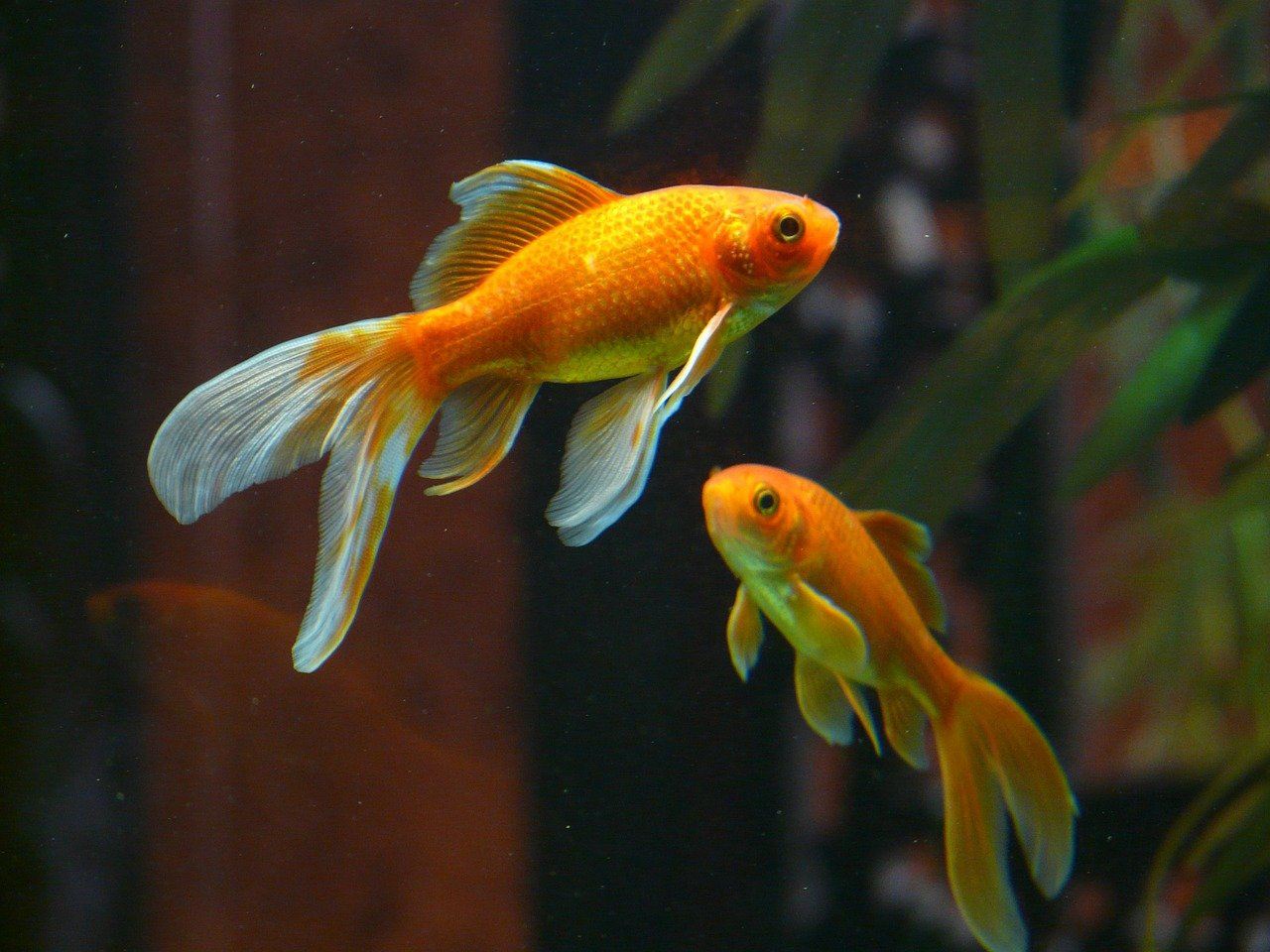
The 10 Step Guide to Goldfish Spawning
1. Plan A Year Ahead
Goldfish can breed at the age of one to two years old. If you are planning to breed goldfish, it’s important to raise them for at least a year before deciding to do so. If you have a young goldfish, you can also watch for illnesses and genetic failures that will occur in the goldfish as it matures. This will help you to see the genetic potential of the goldfish by their health, size, coloration, and body shape.
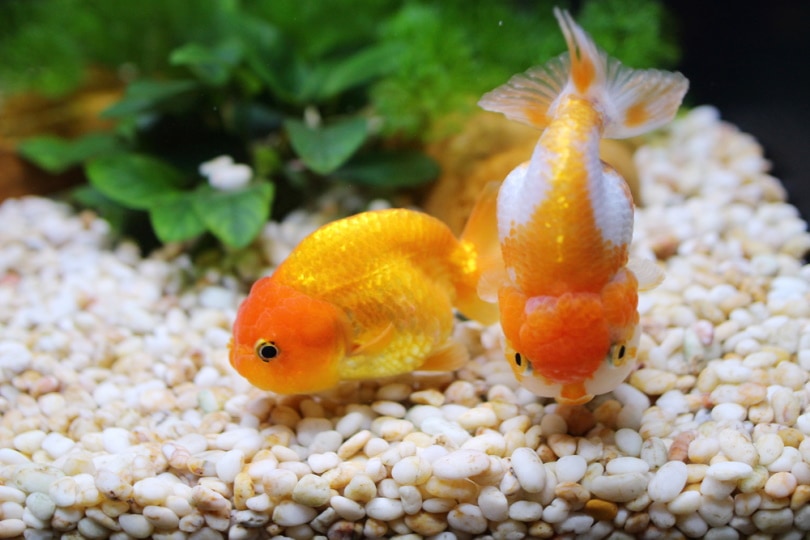
Keep an eye on potential fish you wish to breed, and try to identify them by July or August (goldfish are spring spawners, and prospective parents should be identified by autumn of the previous year). It is a good idea to keep records on any health issues and problems that may occur in your goldfish so you have a good idea of which specimens will make great breeding stock.
2. Seek Professional Input
Once you have identified the fish you wish to breed, have an aquatic veterinarian come and inspect your fish. Alternatively, if you’re not sure which fish should be bred, it’s best to let your veterinarian decide for you. Remember that a fish that looks appealing might not have the best traits of a robust breeder.
The ideal ratio for spawning goldfish is 3 males to every female. If you haven’t sexed your goldfish, you should ask your veterinarian to do so. Your veterinarian may also run blood tests on your fish and advise you on breeding compatibility.
Please note that the health of your female goldfish is very important, as they can easily get injured during the spawning season. If you have a beloved female goldfish, it is best to not breed her.
It is also best to discuss the option of artificial insemination or hand spawning with your veterinarian at this point; many aquatic vets are able to provide this service for a fee. Though it requires additional monetary investment, it minimizes the risk of injury for female fish and increases the number of eggs that are fertilized.
3. “Clean” Breeders
You would want to place the breeding stock in their own large, cycled aquarium. Before doing so, provide each fish with a “cleaning” cycle by placing them one by one in a 5-gallon aquarium and adding in a combination of Formaldehyde, Copper Sulfate, and a broad-spectrum antibiotic (prescribed by your veterinarian).

The dose of Formaldehyde and Copper Sulfate should be discussed with your veterinarian, as the amount you need will vary depending on the concentration of the product you have. The duration of their exposure to the cleaning process should also be discussed with your veterinarian. It is recommended to have your veterinarian perform this procedure for you.
4. Condition In Aquarium
Once your breeders are in their aquarium, it is important to begin conditioning them with foods such as brine shrimp, worms, and a high-quality pellet.
Important: Do not change their diet abruptly, but rather add these food items into their diet gradually.
It is best to feed your goldfish small amounts of food several times a day (three to four times) when conditioning them this way. When feeding your goldfish for the purposes of breeding them, you should feed them as much as they can eat in a few minutes. It is very important to not let leftover food in their aquarium, as this may spoil and degrade the water quality of your breeders’ housing aquarium.
Live food fed to breeders should be sourced from a reputable breeder, as feeding poor-quality live food offers lower nutritional value and may introduce unwanted pathogens into your aquarium.
Your breeders will need to be constantly conditioned from their selection day up and even after they are done spawning, as the process is quite draining on their bodies.
5. Simulate Winter
As goldfish are coldwater fish, they spawn in the springtime. Waiting for seasonal changes can be cumbersome and when breeding goldfish, it’s best to use a chiller to manipulate the temperature.
Winter can be simulated by gradually dropping the temperature in their aquarium to 10 – 12°C (50 – 54°F). You should only decrease the temperature on your chiller by 1 – 2°C (1.6 – 3°F) per day.
Note: your fish will naturally stop eating as temperatures drop and go into a state of near hibernation, called torpor.
6. Simulate Spring
When you are ready to breed your fish, it’s time to simulate springtime. This time, you’ll need a heater to slowly increase the temperature in their aquarium by 1 – 2°C (1.6 – 3°F) per day until you reach 20 – 23°C (68 – 74°F). This process takes about a week or so.
7. Isolate Best Breeders
Begin to identify prospective breeders in your breeder tank. Males that are ideal for spawning should develop small white dots on their gills and heads (known as tubercules), be strong swimmers, and should show interest by chasing females around. Females that are ideal for breeding should be larger than males, and should slowly turn plump.

Isolate a group of 3 males and 1 – 2 females in a 20-gallon spawning aquarium. Ensure it is cycled and maintained at the “spring” temperature.
Important: A 20-gallon aquarium cannot sustain 4 – 5 spawning goldfish for a long period of time and needs daily partial water changes of 20 – 25% to maintain water quality.
8. Wait For Eggs
Observe your females in the spawning tank, as the stimulation from the males eventually makes them drop their eggs, which stick onto the surfaces of the spawning tank. They usually drop their eggs on the plants in the spawning tank.
Once a female drops her eggs, the males fertilize them by releasing their sperm into the water (fertilization is done externally).
9. Remove Adults or Mop Eggs
Remove the adults from the spawning tank, or move the eggs using a spawning mop. You might be able to identify fertile eggs from infertile ones:
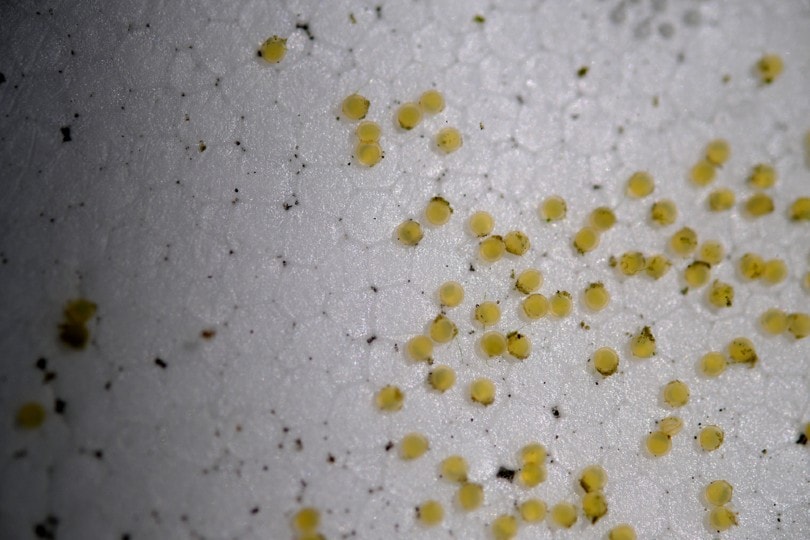
Eggs take 4 – 7 days to hatch; eggs that don’t hatch after 8 days are considered infertile. Infertile eggs should be removed from the aquarium, as they will rot and degrade water quality rapidly.
10. Monitor Fry & Care For Adults
Newborn fry can be fed baby brine shrimp or other foods small enough to fit in their mouths. You can begin the process of raising fry soon after they’ve hatched. Congratulations on your spawn!
Please note that you should also keep an eye on your spawning fish. Females may get injured during the mating process and might require additional care.
Reasons Behind Goldfish Breeding Failure
Sometimes you may run into trouble when trying to breed your goldfish and this is called breeding failure. It is rare, but sometimes goldfish will not breed. If you have followed all the steps to ensure all the right conditions and breeding requirements have no been met, here are a few reasons your goldfish are not breeding:
Conclusion
While breeding is fun and a great way to better the genetic lineage of your goldfish, it does require certain expertise and a massive commitment. Once the eggs hatch, you will then begin caring for the cute mini versions of the adults. Raising fry is an enjoyable experience and will help you follow the full development process of the stock. If you know the basics of good goldfish care, while having much experience in caring for them, you are ready to become a successful fish breeder!
- Related Read: Shipping and Moving Live Goldfish: Step-by-Step Guide
Featured Image Credit: panpilai paipa, Shutterstock




